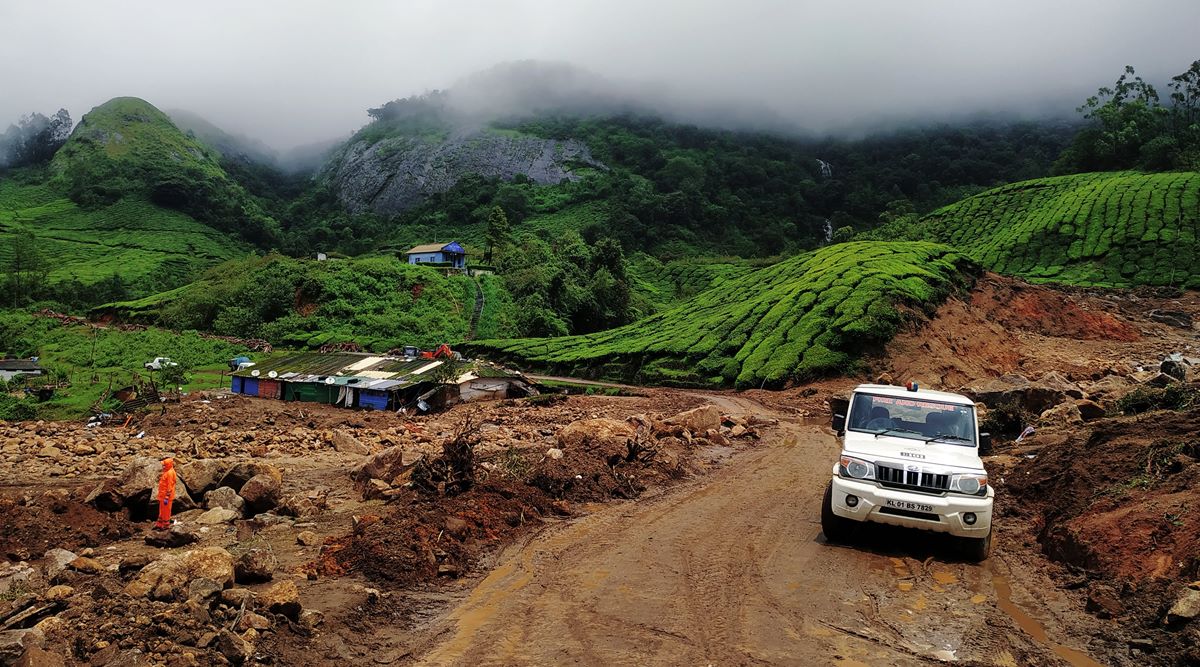 The site of the landslide at Pettimudi, 20 kms from Munnar in Idukki district. (Express Photo by Vishnu Varma)
The site of the landslide at Pettimudi, 20 kms from Munnar in Idukki district. (Express Photo by Vishnu Varma)From a vantage point on the edge of a tea plantation, Selva Kumar watches intently as half a dozen earthmovers steered by men in orange jumpsuits scoop sludge and muck at the site of a deadly landslide in Kerala’s Pettimudi. Every morning, for the past three days, he has been driving up here from his home in a nearby plantation to check on the whereabouts of his good friend Bharathi and his family.
For years together, Kumar and Bharathi drove jeeps down crumbling mountain roads carrying tourists from the popular hill station of Munnar to the Eravikulam National Park, home to the Nilgiri Tahr, an endemic wild goat species, and a bluish purple-colored flower called Neelakurinji that blooms once in 12 years. With their parents employed as workers in tea estates and factories, they have been living over generations in squalid, one-room asbestos-roofed tenaments locally referred to as ‘layams’, a corruption of the word lines. Life was harsh in these ‘layams’, but a sense of belonging as a closely-knit community tethered them to this remote belt in the Western Ghats all these years.
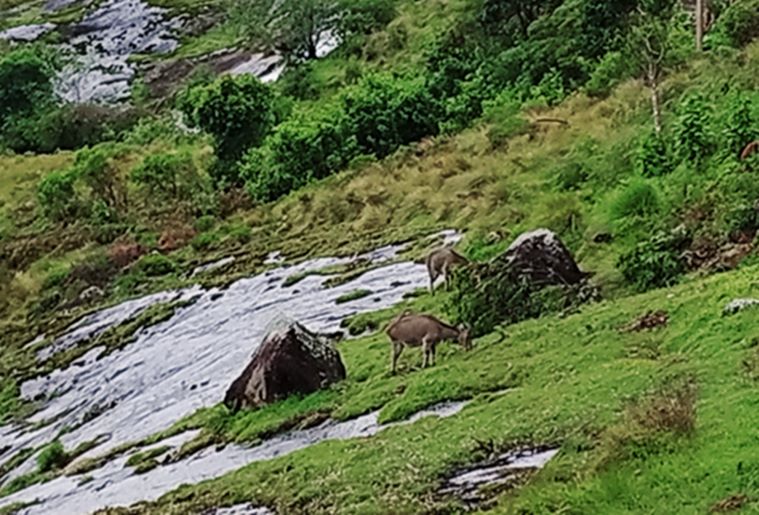 The endemic Nilgiri Tahr, a wild goat species, grazing inside the Eravikulam National Park. (Express Photo by Vishnu Varma)
The endemic Nilgiri Tahr, a wild goat species, grazing inside the Eravikulam National Park. (Express Photo by Vishnu Varma)
That bond however suffered a jolt on the night of August 6 when large chunks of mud, boulders and slush cascaded down a slope in the backdrop of heavy rainfall and crushed four rows of ‘layams’ with 82 people inside. Families like those of Bharathi, with 13 members including his wife and two school-going children aged six and ten, were wiped out overnight. By the time search and rescue operations entered the 19th day, a total of 65 bodies were pulled out from underneath the debris and the banks of an adjoining river, most of them found snuggled in between blankets in the same position they went to sleep that night. Only 12 made out alive, armed with horrific accounts of that rainy night and a disbelief of how they survived.
Quixplained | What triggered Kerala’s Idukki landslide?
For Kumar, the landslide has not just claimed a close friend. It has also subconsciously rewritten the concepts of safety and security of a region where people like him were born and raised in. Like Bharathi, he and his family also live in ‘layams’ a few kilometres away, surrounded by the all-too-familiar green cascade of the tea estates and the looming hills of the Ghats.
So does he feel safe anymore? “Safety is what you see in front of you,” he says, pointing to the mounds of landslide debris where four rows of settlements once stood.
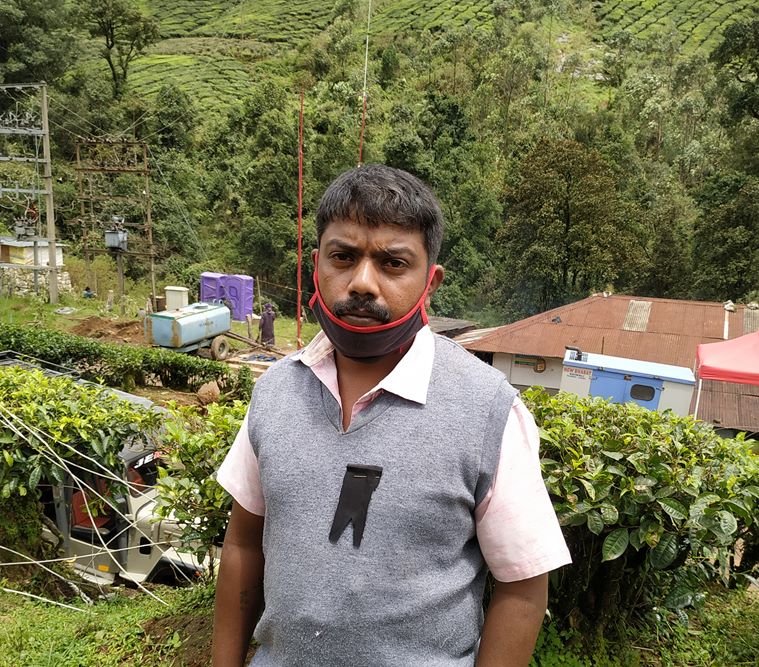 Selva Kumar, a tourist jeep driver, who lost his close friend Bharathi and his family in the landslide. (Express Photo by Vishnu Varma)
Selva Kumar, a tourist jeep driver, who lost his close friend Bharathi and his family in the landslide. (Express Photo by Vishnu Varma)
“We also stay in the same kind of houses in the same conditions, so what can we say (about safety)? There have been no changes over the years. Everything’s the same.”
Kumar acknowledges that many of Pettimudi’s residents whose houses escaped the landslide by a whisker want to relocate. A rehabilitation package of the state government promises a Rs 5 lakh compensation, a piece of land and a home; all attractive incentives for people in these parts to move away as almost all of them are homeless. Kumar’s family, who hail from Virudhanagar district in Tamil Nadu, don’t have a permanent home either, but just the thought of relocating touches a raw nerve.
“Isn’t this our hometown? My ancestors gave their blood and sweat to plant these tea shrubs. They worked hard to make this place liveable for us. My grandfather, followed by my father, then me and in future, my son – all of us would be here. We are not going anywhere,” he makes it clear.
So, doesn’t the possibility of a landslide in future frighten him? “Yes, we are scared,” he starts off. “But how can we say we don’t trust the soil here? In Wayanad, it (landslide) happened. Didn’t they trust the soil there on which they lived for generations? Soil is the same everywhere.”
On the edge of the land, and landslides
Across the Western Ghats in Kerala and beyond, one of the most ecologically fragile mountain systems in the world, conversations of a similar kind on land, rainfall and the cost of marginalised human lives have become increasingly familiar in the last three years especially with the state battered by monsoon-linked calamities. If the year 2018 saw the century’s worst deluge that displaced millions and claimed nearly 500 lives, the 2019 monsoon saw major landslides in Kavalappara and Puthumala, both part of the Ghats. Pettimudi wasn’t an area presumed to beprone to landslip and yet it witnessed the state’s heaviest casualty in a landslip. This confirms what climate scientists and ecologists have been saying all along: an era of climate emergency is sweeping in and with reckless human activities continuing in vulnerable areas, the picture isn’t going to be pretty.
“Kerala is now the experimental laboratory of climate change in the country,” says Dr TV Sajeev, a senior principal scientist at the Kerala Forest Research Institute (KFRI).
“Many years ago, a shola forest atop a hill near Munnar was encroached by a group of people to grow cardamom. In the past, the area was deemed not fit to grow cardamom as it remained foggy half the year. But after it was encroached, the area’s climate pattern changed drastically and it was no longer foggy. The incident was widely reported in the press as just a case of land-grabbing, but in essence, it was the first signature of climate change in Kerala,” he adds.
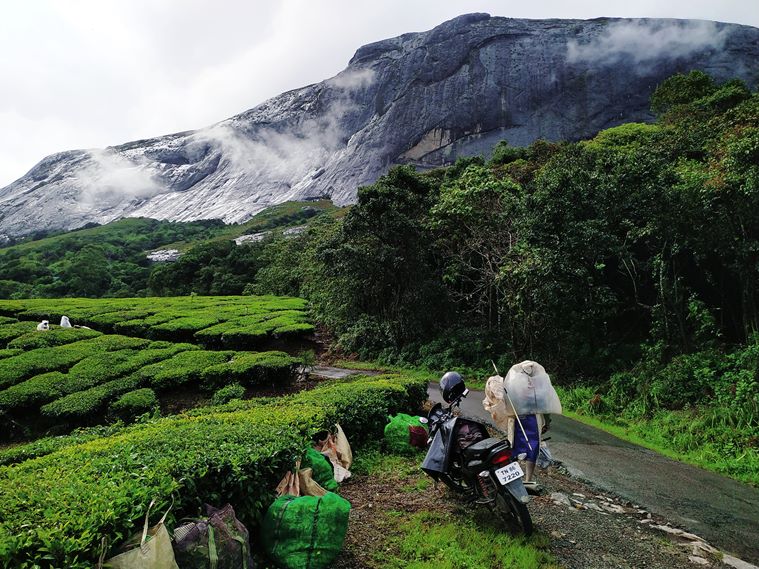 Severe habitat fragmentation has resulted in several flora and fauna species vanishing from Munnar as tea plantations crowded every inch of the valley. (Express Photo by Vishnu Varma)
Severe habitat fragmentation has resulted in several flora and fauna species vanishing from Munnar as tea plantations crowded every inch of the valley. (Express Photo by Vishnu Varma)
What happened in Pettimudi?
In the days leading up to the landslide, locals attested to extremely heavy, uninterrupted rainfall in the region beginning August 1, presumably linked to a low-pressure area that had formed in the Bay of Bengal around the time. Heavy rainfall conditions were predicted by the Meteorological Department in other parts of Kerala too. The continuous rainfall severed power connections in Pettimudi and neighbouring estates in Rajamala, shrouding the region in darkness. According to an estimate, the rain gauges of the Kannan Devan Hills Plantation (KDHP) recorded a high of almost 62 cms rainfall on August 6, the night the landslide took place. If the statistic is true, it validates the changing pattern and nature of monsoon rainfall Kerala has been getting over the past three years: extreme amounts of rain in a short period of time in a particular area.
Experts say if the same amount of rainfall, say 62 cms in Pettimudi, was evened out across a larger geographical region in a week or two, there wouldn’t have been a disaster. But in this case, as seen previously in Kavalappara and Puthumala, the large magnitude of rainfall descended upon a section of the Ghats classified as ‘ecologically sensitive zone 1’ (ESZ1) by the Madhav Gadgil-chaired panel in 2011.
Biju Sebastian, a geologist with the state government who submitted a preliminary report on the landslide to the district collector, says it originated in a shola forest area atop a hill. “Due to excess rainfall, the soil in the shola forest became loose and came down the steep slope of the hill, accumulating boulders and sludge along with it. The path of the debris flow, almost 1.2 kilometres long, has a few bends. There was an existing streamlet along the slope which converged with the debris flow and finally washed down at the bottom over the ‘layams’,” he says.
“It was quite windy as well because we saw some of the tree trunks lying broken around 100 metres from the origin of the landslide. When a tree falls, the roots come loose and the soil is exposed. The rainwater percolates through that gap and destroys the friction between the soil and the rock.”
Authorities say there’s no chance of human intervention as the shola forests atop the hills are remote, uninhabited and under close monitoring of forest watchers. Also, within a 30-km radius of the area, there are no quarries or mining activities.
However, for environmentalists like CR Neelakandan, that justification falls short. Having been classified ‘ESZ1’ by the Gadgil panel report way back in 2011, the area should have been treated as vulnerable and especially with a steep slope, the living conditions of the locals should have been taken into account, he says.
“Pettimudi had a high altitude, so automatically it was disaster-prone. It’s also one of the wettest areas in the state. Even small changes can amplify and cause big impact (in the Ghats),” he says, over a phone call.
“There’s no doubt the rain played a big factor… but a landslide doesn’t need a single reason. There can be multiple reasons, just as a multiple-organ failure can lead to death in a human body. We need to check if there has been a change in vegetation, especially in the sloped areas because vegetation can decide the relationship between the rainfall and the soil. That’s why we need scientific studies to be done at the landslide site,” he adds.
The politics of environment
On August 13, exactly a week after the landslide, when activist Gomathy heard that Chief Minister Pinarayi Vijayan was coming to Pettimudi that day to meet survivors and families of the deceased, she hoped to meet him and apprise him of the living conditions of plantation workers. As his convoy passed through Munnar town, Gomathi attempted to flag his car down, but instead got arrested and taken to the police station.
“The previous night, I had visited a relief camp where there were families who had escaped the landslide, but whose ‘layams’ were swept away. They were in so much pain that they were holding my hand and weeping. They told me, ‘Gomathy, please do something. We wish we were buried in the landslide rather than having to continue living in those quarters.’ I wanted to relay their concerns to the chief minister,” says Gomathy, an elected representative who was once a firebrand leader of the ‘Pembilai Orumai’ outfit that organised protests in 2015 seeking better wages and housing for women plantation workers.
“I asked the police officer if I could have five minutes with the chief minister. But they didn’t listen and pushed me aside as the convoy passed,” she adds.
Idukki landslide | Kerala CM Pinarayi Vijayan promises land, homes for those affected
Land and safe housing, she underlines, continue to be the most pressing issues for over 15,000 plantation workers in estates in and around the town of Munnar, a majority of whom belong to the Scheduled Caste (SC) community and migrated from Tamil Nadu over the last century as tea gardens cropped up in the region. Even as the Covid-19 pandemic rages across the state, social distancing norms are forced to be thrown out the window as two or more families are scrunched together in these highly dilapidated layams.
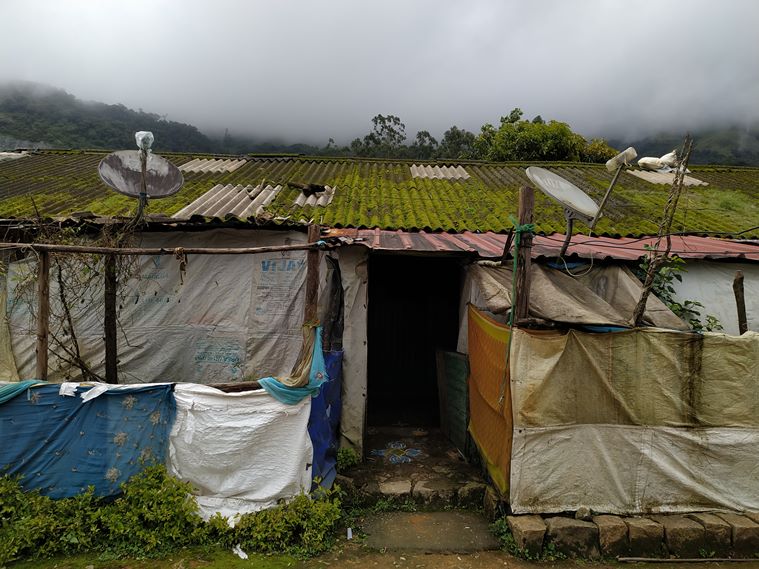 In single-room huts like these are cramped families of plantation workers in Munnar and beyond. (Express Photo by Vishnu Varma)
In single-room huts like these are cramped families of plantation workers in Munnar and beyond. (Express Photo by Vishnu Varma)
“The commission set up by MG Rajamanickam has stated very clearly how the land leased out to tea companies belongs to the Revenue Department. A portion of the land must be distributed to plantation workers, Dalits and Adivasis where they can build homes and practice farming,” Gomathy says.
However, in 2017, when an army of women under the banner of Pembilai Orumai took out protests in the region demanding urgent corrective steps, it was brutally put down by the CPM-led government with the help of a large police contingent. The women were also publicly humiliated by MM Mani, the state’s power minister and a senior CPM leader from Idukki who accused them of engaging in immoral activities for personal gains.
And so, in the absence of any incremental progress on land reforms even in a state ruled by the Left, it shouldn’t come off as a surprise that the poorest and marginalised sections bear the brunt of ecological and climate change-related disasters, say ecologists.
Fact Check | A look at how the Idukki landslide occurred
Sajeev of KFRI says, “We have to ask ourselves how people in those regions lived over a 100 years without any concrete improvements in their lifestyle. We talk so much about the Kochi Metro, the transhipment terminal and Kerala’s high living index, but why are the living conditions of people (in places like Pettimudi) not inching forward at all? Whenever there are environmental changes leading to a disaster, it’s always the poorest of the poor who are affected.”
“That’s why this is no longer an ecological issue. This is a human rights issue.”
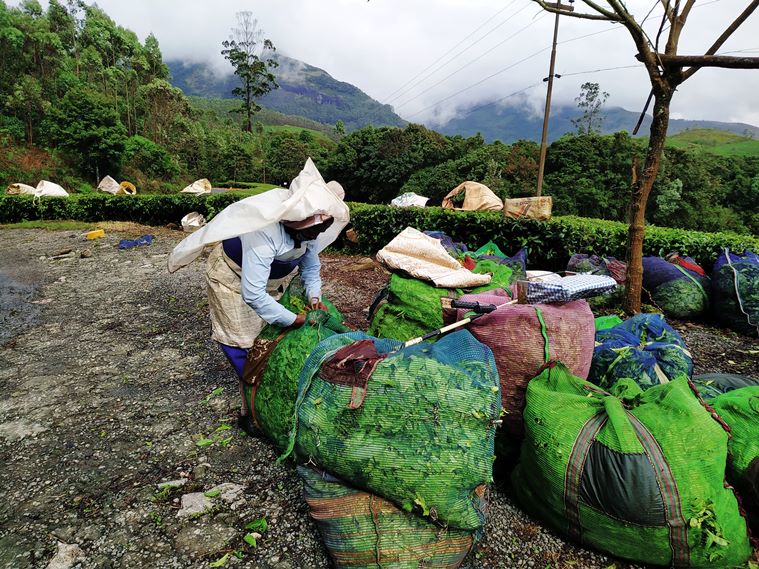 A woman packing bags of tea leaves at the end of her shift. (Express Photo by Vishnu Varma)
A woman packing bags of tea leaves at the end of her shift. (Express Photo by Vishnu Varma)
Development for whom?
Sample these news headlines over the past three years in Kerala.
“Kerala to oppose quarry distance norms, greens blame it on lobby.”
“Scientist faces ire of quarry owners.”
“MM Mani’s brother, kin charged in Chinnakanal land grab case.”
“Forest cover in Western Ghats to fall to 10% in 10 years: Study.”
Despite the state being battered by back-to-back, debilitating calamities, these headlines offer a snapshot of the large-scale, land-altering changes being made across Kerala’s densely-populated landscape, especially in the fragile Western Ghats. Quarries and stone-crushing units continue to operate in ecologically sensitive areas. Highways are being unscientifically carved out of hills.
Deforestation and encroachment of public land continues. And mega infrastructure projects are signed off in Thiruvananthapuram without a proper environment impact study.
In fact, the Economic Review 2019 of the state planning board following the 2018 floods is unambiguous in its findings. “Forest fragmentation was a major contributing factor to the landslides.
Destabilisation of slopes due to cutting, and creation of escarpments more than 3 m for construction purposes, construction of check dams on steep slopes, quarrying in vulnerable areas aggravated the vulnerability,” it read.
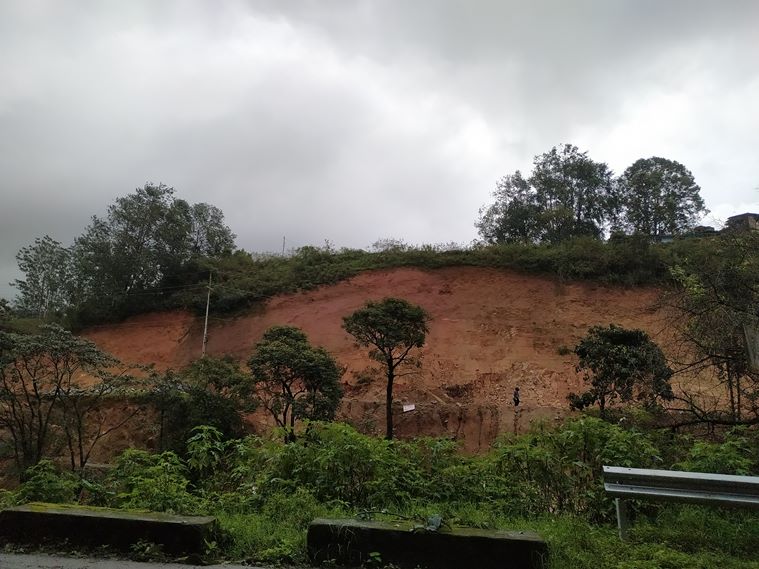 A minor landslide on one of the Ghat roads near Munnar. (Express Photo by Vishnu Varma)
A minor landslide on one of the Ghat roads near Munnar. (Express Photo by Vishnu Varma)
In that context, ecologists have repeatedly cited the 2011 Gadgil panel report as the ideal blueprint to address the concerns in the Ghats so as to prevent future calamities. But even a passing mention of the report in parts like Idukki inflames passions among the locals who consider it ‘impractical’ and purportedly invented to displace them and rob their livelihoods. In the run up to the 2014 Lok Sabha elections in Idukki, the report and its ramifications became a rallying cry for vested religious groups and corporate lobbies to garner vote-banks.
Environmentalist Neelakandan says, “So many lies were peddled here about the Gadgil report. That every house will have to be painted green, that every household must hold water for the tigers to drink, that the areas you live in will become part of the tiger corridor and that babies cannot cry or else the tiger will come. Absolute nonsense was peddled. On the contrary, Gadgil said his recommendations must be translated into local languages and discussed at forums of local gram sabhas. Such gram sabhas must have the authority to approve projects.”
“But the unfortunate aspect is that our local bodies remain in the hangover of mainstream political parties. In a panchayati raj system, the gram sabha is supposed to be the most powerful body. But in Kerala, it’s not like that. Our local bodies are not decentralised or democratic in any way. That’s why political parties detest Gadgil. They are not in favour of political power going down to the grassroots,” claims Neelakandan.
A case in point is Munnar, flocked by thousands of tourists round-the-year but stewing in a continuous state of disrepair, thanks to a series of encroachments of government land by religious groups and real estate lobbies most of which go unchecked by local bodies. If one drives up from the town of Adimali to Munnar through Anachal, one can spot several multi-storeyed resorts and hotels jutting out in areas which are classified vulnerable and not fit for large-scale development.
A lawyer who deals in encroachment cases in Munnar said on condition of anonymity, “Inquiries by
government officials have found that in many village offices and tahsildar’s offices, the corresponding registers of title-deeds are tampered. Many files are missing… in fact, some of the title deeds of encroachers have exchanged hands so many times that they are now paraded as deeds of original settlers. It’s a very scary scenario.”
“Those building illegal structures may be getting permits from the local panchayats. But even today, there is no solid mechanism for the government to check if the land on which they are building has been encroached, or if the title deeds they possess are forged. Inquiries by principal secretary-rank officers on such actions have been submitted to the government, but there has been no action. It points to the kind of political pressure that exists,” the lawyer said.
And despite all this so-called development which is scarring the environment, basic infrastructure is missing. The critically-injured in the Pettimudi landslide had to be driven three-and-a-half hours down the twists and turns of Ghat roads to the Kolenchery Medical College Hospital because a the state that prides itself on its health indicators still does not have a government super-speciality hospital in the high-ranges.